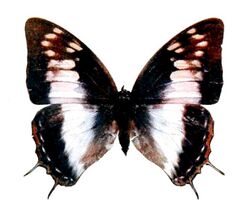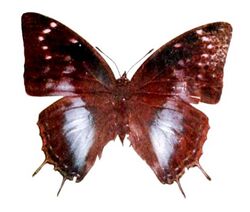Biology:Charaxes ethalion
| Satyr emperor | |
|---|---|

| |

| |
| Two female specimens | |
| Scientific classification | |
| Domain: | Eukaryota |
| Kingdom: | Animalia |
| Phylum: | Arthropoda |
| Class: | Insecta |
| Order: | Lepidoptera |
| Family: | Nymphalidae |
| Genus: | Charaxes |
| Species: | C. ethalion
|
| Binomial name | |
| Charaxes ethalion (Boisduval, 1847)[1]
| |
| Synonyms | |
| |
Charaxes ethalion, the satyr emperor or satyr charaxes, is a butterfly of the family Nymphalidae. It is found in southern Africa.[2]
Description
The wingspan is 45–55 mm in males and 50–63 mm in females.[3] Ch. ethalion Bdv. Very nearly allied to c. etheocles and only differing in the male in the genital armature and in the female in having the cell of the forewing above unicolorous, never with light spots. Male: wings above velvety black, almost without metallic gloss. Forewing above without marginal spots and at most with a postdiscal and a discal spot; spot in the cell often absent. Hindwing with small or indistinct whitish submarginal dots and greenish, in cellules 4–6 often red-yellow marginal streaks. The female is similar to that of etheocles f. etheocles, but has no spot in the cell of the forewing. The markings are white, ochre-yellow or bluish. Cape to British East Africa. — Larva unicolorous green with a yellowish-bordered spot on the sixth segment. —ab. kitungulensis Strand has two postdiscal spots in 6 and 7, but no other light spots on the forewing. German East Africa.[4] A full description is also given by Rothschild, W. And Jordan, K., 1900 Novitates Zoologicae Volume 7:478-479 [1] (for terms see Novitates Zoologicae Volume 5:545-601 [2])
Biology
The habitat is forest and dense moist savanna, including Brachystegia woodland.
Larvae feed on Albizia spp., Newtonia buchananii, Peltophorum africanum, Dichrostachys cinerea, Acacia ataxacantha, and Scutia myrtina.[2][3][5]
Notes on the biology of ethalion are given by Pringle et al. (1994), and Kielland, J. (1990).[6][7]
Subspecies
Listed alphabetically:[2]
- C. e. binghami Henning, 1982 (Zambia, northern Zimbabwe)
- C. e. ethalion Boisduval, 1847 (Mozambique, eastern Zimbabwe, Eswatini, South Africa: Limpopo Province, Mpumalanga, KwaZulu-Natal)
- C. e. fisheri Henning, 1982[8] (Zambia: north to the southern part of Lake Tanganyika)
- C. e. handmani Henning, 1982 (Malawi: south to the Mlanje district)
- C. e. kikuyuensis van Someren, 1967[9] (Kenya: highlands east of the Rift Valley)
- C. e. kitungulensis Strand, 1911.[10] (Tanzania, Malawi, Democratic Republic of the Congo: Lualaba, Shaba, Maniema)
- C. e. littoralis van Someren, 1967 (eastern Kenya, eastern Tanzania)
- C. e. marsabitensis van Someren, 1967 (Kenya: north to Mount Marsabit)
- C. e. nyanzae van Someren, 1967 (Uganda, south-western Kenya, western Tanzania, Democratic Republic of the Congo: east to Lake Mweru)
Similar species
Charaxes pondoensis and Charaxes karkloof
Taxonomy
Charaxes ethalion is a member of the large species group Charaxes etheocles.
Realm
References
- ↑ Boisduval, J.B.A. 1847. Catalogue des Lépidoptères recuillie par M. Delagorgue pendant les années 1838-1844 à Port-Natal, au pays de Amazoulous et dans la contrée de Massilicatzi.22 In: Delegorgue, M.A. Voyage dans l’Afrique australe 2: 585-602. Paris.
- ↑ 2.0 2.1 2.2 "Charaxes Ochsenheimer, 1816" at Markku Savela's Lepidoptera and Some Other Life Forms
- ↑ 3.0 3.1 Woodhall, Steve (2005). Field Guide to Butterflies of South Africa. Cape Town, South Africa: Struik. ISBN 978-1-86872-724-7.
- ↑ Aurivillius, [P.O.]C. 1908-1924. In: Seitz, A. Die Großschmetterlinge der Erde Band 13: Abt. 2, Die exotischen Großschmetterlinge, Die afrikanischen Tagfalter, 1925, 613 Seiten, 80 Tafeln (The Macrolepidoptera of the World 13).Alfred Kernen Verlag, Stuttgart.
 This article incorporates text from this source, which is in the public domain.
This article incorporates text from this source, which is in the public domain.
- ↑ "HOSTS - The Hostplants and Caterpillars Database at the Natural History Museum". https://www.nhm.ac.uk/our-science/data/hostplants/search/index.dsml?PSpeciesqtype=starts+with&noRecMsg=Sorry+-+no+records+found.++Please+try+again.&PGenus=Microberlinia&PFamilyqtype=starts+with&sort=Family&searchPageURL=index.dsml&Familyqtype=starts+with&Speciesqtype=starts+with&Genusqtype=starts+with&PGenusqtype=starts+with&Country=Afrotropical.
- ↑ Pringle et al , 1994. Pennington’s Butterflies of Southern Africa, 2nd edition
- ↑ Kielland, J. 1990. Butterflies of Tanzania. Hill House, Melbourne and London: 1-363.
- ↑ Henning , S.F. 1982 Descriptions of three new subspecies of Charaxes ethalion Boisduval from central Africa (Lepidoptera, Nymphalidae). Miscellanea Entomologica 49: 83-91
- ↑ van Someren , V.G.L. 1967 Revisional notes on African Charaxes (Lepidoptera: Nymphalidae). Part IV. Bulletin of the British Museum (Natural History) (Entomology) 18: 277-316.
- ↑ Strand, E . 1911 Zoologische Ergebnisse der Expedition des Herrn Hauptman a, D. Fromm 1908/09 nach Deutsch-Ostafrika. 1. Lepidoptera. Mitteilungen aus dem Zoologischen Museum in Berlin 5: 275-304.
External links
- Charaxes ethalion images subspecies and forma
at Consortium for the Barcode of Life.
- Images of C. ethalion ethalion Royal Museum for Central Africa (Albertine Rift Project)
- Images of C. ethalion kikuyuensis (Albertine Rift Project)
- Images of C. ethalion kitungulensis (Albertine Rift Project)
Wikidata ☰ Q8356068 entry
 |


